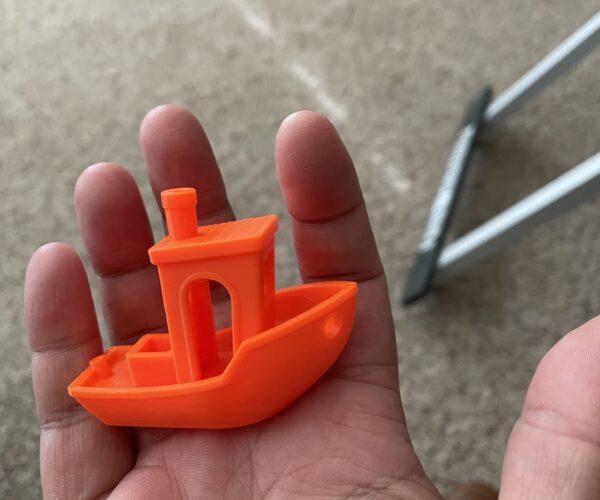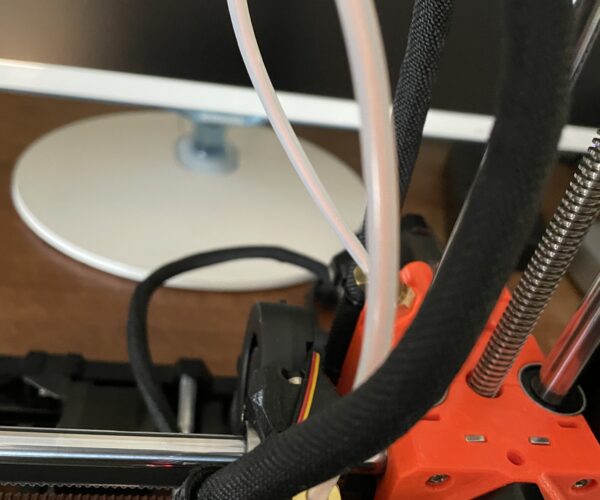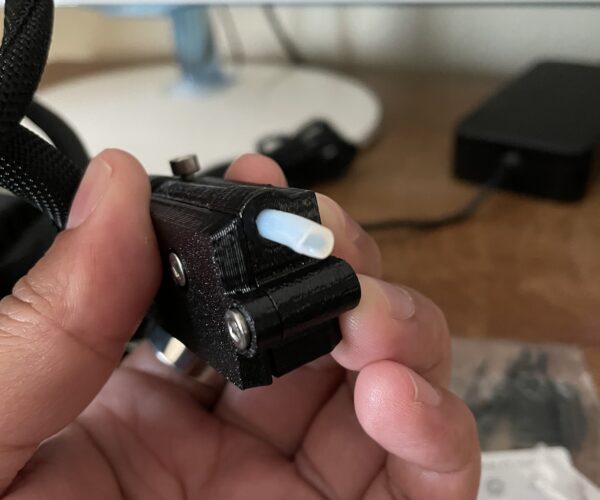Assembled yesterday. Broken PTFE tubing??
I built my semi-assembled kit yesterday. After (many) first print calibrations, settled on -1.5 live z-adjust. Printed a *beautiful* Benchy. I then tried to print a screw. This is where things started to go wrong.... I ran out of Prusament mid-print, so loaded GizmoDorks. That being said, I do not have a spool for this size, so I basically left the filament on the table (just like the prusament samples). Everything was printing fine for quite a few layers. I woke up this morning and the filament was in a knot at the PTFE entry point and clearly the print failed. Now, the filament is jammed in the PTFE tubing.
I heated it to 215 and used the accupuncture needle to clear it out (no luck). I have done this about 8 times. Do I need to just completely change the PTFE tubing?? Any advice?
RE: Assembled yesterday. Broken PTFE tubing??
I built my semi-assembled kit yesterday. After (many) first print calibrations, settled on -1.5 live z-adjust. Printed a *beautiful* Benchy. I then tried to print a screw. This is where things started to go wrong.... I ran out of Prusament mid-print, so loaded GizmoDorks. That being said, I do not have a spool for this size, so I basically left the filament on the table (just like the prusament samples). Everything was printing fine for quite a few layers. I woke up this morning and the filament was in a knot at the PTFE entry point and clearly the print failed. Now, the filament is jammed in the PTFE tubing.
I heated it to 215 and used the accupuncture needle to clear it out (no luck). I have done this about 8 times. Do I need to just completely change the PTFE tubing?? Any advice?
I would get a meter of PTFE tube as a reserve, because they can always break down. As you can cut a suitable length and add chamfers with this tool.
wbr,
Karl
Statt zu klagen, dass wir nicht alles haben, was wir wollen, sollten wir lieber dankbar sein, dass wir nicht alles bekommen, was wir verdienen.
shouldn't be too hard
From your pictures, I think you've got a fairly easy fix. The extruder is on the Z axis, and pushes the filament down the tube to the hot end. At this point, poking at the hot end isn't going to help, because (in theory) nothing is jammed there, it's just that the extruder doesn't have a good grip on the filament to move it around. If you unscrew the tube where it connects to the extruder, you'll probably be able to grab the filament on that end and pull it out (when it is properly heated up, don't try this cold).
Tubing
I built my semi-assembled kit yesterday. After (many) first print calibrations, settled on -1.5 live z-adjust. Printed a *beautiful* Benchy. I then tried to print a screw. This is where things started to go wrong.... I ran out of Prusament mid-print, so loaded GizmoDorks. That being said, I do not have a spool for this size, so I basically left the filament on the table (just like the prusament samples). Everything was printing fine for quite a few layers. I woke up this morning and the filament was in a knot at the PTFE entry point and clearly the print failed. Now, the filament is jammed in the PTFE tubing.
I heated it to 215 and used the accupuncture needle to clear it out (no luck). I have done this about 8 times. Do I need to just completely change the PTFE tubing?? Any advice?
I would get a meter of PTFE tube as a reserve, because they can always break down. As you can cut a suitable length and add chamfers with this tool.
wbr,
Karl
I will echo this. You will go through a bit of tubing over the life of the printer.
--------------------
Chuck H
3D Printer Review Blog
RE: I Bought Precut Tubing From Prusa
I would get a meter of PTFE tube as a reserve, because they can always break down. As you can cut a suitable length and add chamfers with this tool.
wbr,
Karl
I will echo this. You will go through a bit of tubing over the life of the printer.
I just purchased a few precut hot end pieces from Prusa for $0.89 each along with an order for other stuff that makes the shipping reasonable. I figured it was not worth the hassle of trying to cut and chamfer it exactly. If I get it precut, that is one variable removed.
The other pieces don't have to be a perfect length or have perfect chamfers, so I would use other tubing for them. I'm not convinced that the Capricorn tubing can actually withstand higher temperatures but is does appear that they use additives to make teflon even slipperier, if that is possible. That might be useful in the Bowdon tube. I have found that loading and unloading works better if the head is all the way to the left, making less of a curve in the Bowden tube.
I wonder how long the additives last. Pure PTFE is pretty chemically inert. PVC loses it's plasticizers over time and becomes brittle. I'm not sure if that same mechanism would come into play. I am not a polymer chemist.
Regards,
Mark
PTFE
I would get a meter of PTFE tube as a reserve, because they can always break down. As you can cut a suitable length and add chamfers with this tool.
wbr,
Karl
I will echo this. You will go through a bit of tubing over the life of the printer.
I just purchased a few precut hot end pieces from Prusa for $0.89 each along with an order for other stuff that makes the shipping reasonable. I figured it was not worth the hassle of trying to cut and chamfer it exactly. If I get it precut, that is one variable removed.
The other pieces don't have to be a perfect length or have perfect chamfers, so I would use other tubing for them. I'm not convinced that the Capricorn tubing can actually withstand higher temperatures but is does appear that they use additives to make teflon even slipperier, if that is possible. That might be useful in the Bowdon tube. I have found that loading and unloading works better if the head is all the way to the left, making less of a curve in the Bowden tube.
I wonder how long the additives last. Pure PTFE is pretty chemically inert. PVC loses it's plasticizers over time and becomes brittle. I'm not sure if that same mechanism would come into play. I am not a polymer chemist.
Regards,
Mark
I too have purchased them to be less of a hassle. I did start making my own recently because of the cost of shipping.
--------------------
Chuck H
3D Printer Review Blog
Update
I ended up just really heating up the hot end, cleaning out the inside of it, using the needle tool. Then I had to re-assemble and reset the sensor. I decided in the future, I will use this cutter to cut the PTFE for the hot end to size. Luckily, the current one actually did not have any damage and really it was the PLA stuck in the nozzle. Heating it up to 230 really did the trick to melt it all off and cleaning. I was reading that I also need to get some cleaning filament as well.
Here is the link to the PTFE cutter:
https://www.prusaprinters.org/prints/65909-prusa-mini-ptfe-hotend-tube-cutter-guide-43mm
PTFE cutter
You may also appreciate this PTFE cutter that is printed exactly to the right size for the MINI
https://www.prusaprinters.org/prints/65909-prusa-mini-ptfe-hotend-tube-cutter-guide-43mm



